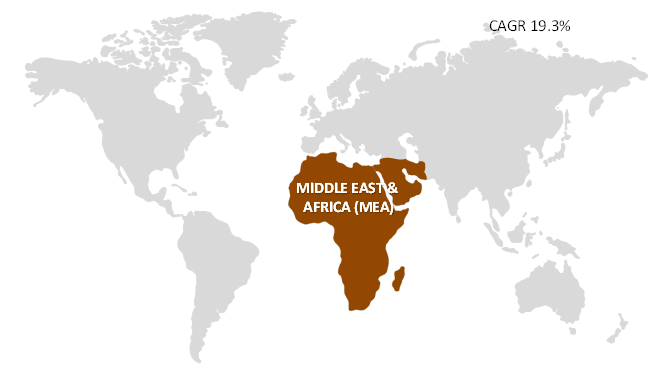Pages: 73
Pressure vessel offer excellent compromise between low weigh and high mechanical properties. The composite materials that are mainly employed in the making of pressure vessels are epoxy resin and fibers. These materials are decided on the basis of their reliability and safe operation. Therefore it becomes a crucial task for determining the correct material. The pressure vessel composite materials do not dissolve and blend into each other making a perfect combination. The materials used provide high energy saving and helps in boosting efficiency and also the durability of the pressure vessels.

Strategic insights for the Middle East & Africa Pressure Vessel Composites Material provides data-driven analysis of the industry landscape, including current trends, key players, and regional nuances. These insights offer actionable recommendations, enabling readers to differentiate themselves from competitors by identifying untapped segments or developing unique value propositions. Leveraging data analytics, these insights help industry players anticipate the market shifts, whether investors, manufacturers, or other stakeholders. A future-oriented perspective is essential, helping stakeholders anticipate market shifts and position themselves for long-term success in this dynamic region. Ultimately, effective strategic insights empower readers to make informed decisions that drive profitability and achieve their business objectives within the market.

| Report Attribute | Details |
|---|---|
| Market size in 2019 | US$ 65.98 Million |
| Market Size by 2027 | US$ 269.04 Million |
| CAGR (2020 - 2027) | 19.3 % |
| Historical Data | 2017-2018 |
| Forecast period | 2020-2027 |
| Segments Covered |
By Material
|
| Regions and Countries Covered | Middle East and Africa
|
| Market leaders and key company profiles |
|
The geographic scope of the Middle East & Africa Pressure Vessel Composites Material refers to the specific areas in which a business operates and competes. Understanding local distinctions, such as diverse consumer preferences (e.g., demand for specific plug types or battery backup durations), varying economic conditions, and regulatory environments, is crucial for tailoring strategies to specific markets. Businesses can expand their reach by identifying underserved areas or adapting their offerings to meet local demands. A clear market focus allows for more effective resource allocation, targeted marketing campaigns, and better positioning against local competitors, ultimately driving growth in those targeted areas.

The Middle East & Africa pressure vessel composites material market is expected to reach US$ 269.04 Million in 2027 from US$ 65.98 Million in 2019. The market is anticipated to grow at a CAGR of 19.3 % from 2020 to 2027. Factors driving the market growth include increasing natural gas vehicles and increasing demand for pressure vessels from various end-user industries. However, storage capacity of composite pressure vessels is likely to have a negative impact on the market growth.
The ongoing COVID-19 outbreak began in Wuhan (China) in December 2019, but later it spread to all the parts of the world. It has adversely affected the chemicals and materials industry as the industry is suffering from supply chain disruptions, lockdowns, travel bans, and business shutdowns called in various countries. The South Africa has the highest number of confirmed cases of the COVID-19 morbidity among all Middle East & African countries. This is likely to impact the chemicals and materials industry in the region due to the disruption of supply and distribution chain. In addition, the lockdown scenarios are also impacting the overall manufacturing processes, research, and development activities pertaining to different industries.
The resin segment accounted for a larger share of the Middle East & Africa pressure vessel composites material market, by material, in 2019. The CNG vehicles segment accounted for a larger share of the Middle East & Africa pressure vessel composites material market, by end user, in 2019.
A few of the major primary and secondary sources referred to while preparing this report on the Middle East & Africa pressure vessel composites material market include 3M Company, BASF SE, Hexion Inc., Huntsman International LLC., Olin Corporation, Solvay S.A.,. and ZOLTEK Corporation (Toray Group).
The Middle East & Africa Pressure Vessel Composites Material Market is valued at US$ 65.98 Million in 2019, it is projected to reach US$ 269.04 Million by 2027.
As per our report Middle East & Africa Pressure Vessel Composites Material Market, the market size is valued at US$ 65.98 Million in 2019, projecting it to reach US$ 269.04 Million by 2027. This translates to a CAGR of approximately 19.3 % during the forecast period.
The Middle East & Africa Pressure Vessel Composites Material Market report typically cover these key segments-
The historic period, base year, and forecast period can vary slightly depending on the specific market research report. However, for the Middle East & Africa Pressure Vessel Composites Material Market report:
The Middle East & Africa Pressure Vessel Composites Material Market is populated by several key players, each contributing to its growth and innovation. Some of the major players include:
The Middle East & Africa Pressure Vessel Composites Material Market report is valuable for diverse stakeholders, including:
Essentially, anyone involved in or considering involvement in the Middle East & Africa Pressure Vessel Composites Material Market value chain can benefit from the information contained in a comprehensive market report.